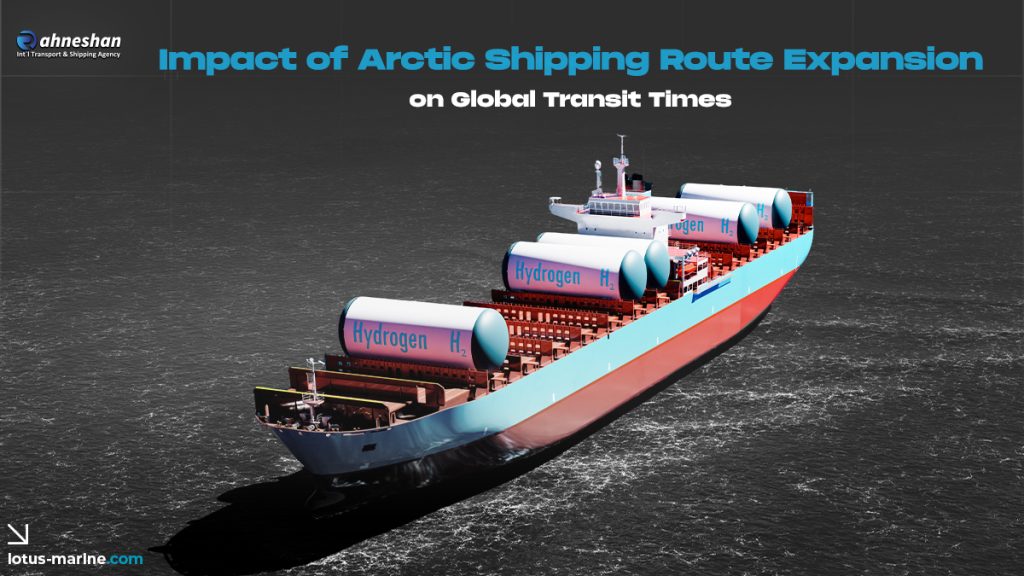Introduction
As sea ice retreats seasonally and ice-class technology advances, the Arctic shipping routes—notably the Northern Sea Route (NSR) along Russia’s Siberian coast and the Northwest Passage (NWP) through the Canadian Arctic—are drawing new interest from carriers. Proponents argue these routes can shorten Asia–Europe voyages by thousands of nautical miles. Yet the time savings are far from guaranteed: seasonality, ice restrictions, convoy rules, and limited infrastructure often offset theoretical gains. This article unpacks when, how, and for whom Arctic routes can actually reduce global transit times, and what trade-offs come with them.
How Arctic Routes Can Cut Transit Time
1) Shorter Great-Circle Distances
-
Shanghai → Rotterdam
-
Via Suez Canal: ~10,500–11,000 nm
-
Via NSR (seasonal): ~6,500–7,000 nm
-
Potential distance reduction: 30–40%
-
-
Yokohama → Hamburg
-
Via Suez: ~11,400 nm
-
Via NSR: ~7,800–8,300 nm
-
Potential distance reduction: 25–35%
-
What this means: On paper, fewer miles can translate into 7–12 days saved for typical container or bulk carriers cruising 14–18 knots—if the Arctic leg can be sailed at planned speed without escorts or weather holds.
2) Seasonal Weather Windows
-
The most reliable navigation window on the NSR typically spans late summer to early autumn (e.g., August–October), when sea ice is at a minimum and more segments are free-navigable for ice-class ships.
-
Outside this window, ice thickness, drifting floes, and polar lows can force speed reductions, route detours, or waiting for icebreaker convoys, eroding time savings.
3) Ice-Class & Icebreaker Support
-
Ice-class hulls and experienced polar crews allow higher average speeds in light ice, but convoy rules and ice pilotage requirements can add queueing and coordination time.
-
Icebreaker escort can help maintain schedule certainty in shoulder seasons, but rendezvous, permit processing, and escort speeds may reduce the headline advantage.
When Arctic Routes Don’t Save Time
Operational Friction That Adds Days
-
Permitting & Reporting: Polar codes, regional permits, and route approvals can add administrative lead time.
-
Speed Caps: Safety speed limits in ice or poor visibility lower the effective voyage speed.
-
Limited Diversion Ports: Fewer safe havens and repair facilities mean conservative routing and additional contingency buffers.
-
Convoy & Pilot Scheduling: Missing an escort window can mean waiting 24–72 hours.
-
Weather Variability: Polar lows and fog reduce speed or force heave-to periods.
Cargo & Vessel Type Constraints
-
Ultra-large container vessels (ULCVs) and many standard boxships are not ice-classed; chartering or re-routing smaller ice-class tonnage can break network cadence and negate time gains.
-
Time-sensitive reefer/pharma cargo may prefer predictable Suez timing over seasonal Arctic variability.
Time vs. Reliability: The Scheduling Equation
| Factor | Suez Canal Route | Arctic Route (NSR/NWP) |
|---|---|---|
| Average Schedule Reliability | High, year-round | Medium–low, seasonal |
| Transit Time Variability | Low–moderate (canal queues, geopolitics) | Moderate–high (ice, weather, convoy) |
| Operational Buffer Needed | Standard | Elevated (permits, ice risk, escorts) |
| Diversion & Rescue Options | Many ports, services | Sparse infrastructure |
| Typical Time Advantage | — | Up to 7–12 days in optimal windows |
Takeaway: The Arctic can be faster in best-case conditions, but less predictable overall. Shippers must weigh speed vs. reliability and the cost of larger buffers.
Geopolitical, Environmental, and Cost Trade-Offs
-
Geopolitics & Access: Portions of the NSR require Russian permissions and services; sanctions or regional tensions can affect access, costs, and insurance.
-
Insurance & Risk Premiums: Hull, P&I, and war risk premiums may rise for polar voyages; ice damage deductibles and special survey requirements add time/cost.
-
Fuel & Emissions: Shorter routes can reduce fuel burn, but slow steaming in ice, detours, or escort fees may offset savings. Black carbon and sensitive ecosystems increase ESG scrutiny.
-
Cost of Capability: Ice-class upgrades, crew training, polar equipment (e.g., de-icing systems), and specialized comms raise OPEX/CAPEX.
Practical Use Cases (Where Time Savings Are Real)
-
Northeast Asia ↔ Northern Europe Bulk Trades
Ice-class bulkers hauling ores, metals, or project cargo can achieve meaningful time cuts in late summer—especially when schedules are flexible and shippers accept seasonal routing. -
Project & Breakbulk With Tight Windows
Over-dimensional cargoes avoiding congested canals may capture single-voyage time gains that justify escort and premium costs. -
Niche Liner Services (Seasonal)
Smaller, ice-class feeder services connecting Arctic ports or northern gateways can align schedules to the season, offering predictable—if limited—windows.
Strategic Planning Checklist for Shippers & Carriers
-
Lane Scoring: Compare distance, historical ice maps, escort rules, and port options vs. Suez/Cape alternatives for each lane.
-
Seasonal Calendars: Lock sailing windows and buffer days by month; plan contingencies for early freeze-up or late melt.
-
Vessel Suitability: Confirm ice class, heating, de-icing, comms redundancy, and crew polar competencies.
-
Cost Model: Incorporate escort fees, premiums, permits, and delays; stress-test fuel/emissions outcomes at different speeds and ice states.
-
Contract Design: Build force-majeure, deviation, and schedule-variance clauses; consider parametric insurance for weather/ice triggers.
-
ESG & Compliance: Align with Polar Code, spill prevention, wildlife protections, and black carbon mitigation practices.
Conclusion
Arctic route expansion can reduce global transit times—sometimes dramatically—but only under the right conditions. For select lanes and seasons, ice-class ships can shave a week or more off Asia–Europe voyages. Yet variability, regulatory friction, and infrastructure limits mean the predictability of Suez often wins for high-frequency liner networks and time-critical cargo. The competitive play is portfolio-based: use the Arctic tactically during optimal windows, while maintaining robust Suez/Cape contingencies, resilient contracts, and clear ESG governance.
Frequently Asked Questions (FAQs)
1) How many days can the Arctic save vs. Suez?
In optimal late-summer windows, select Asia–Northern Europe voyages can be 7–12 days faster. Outside those windows, variability can erase gains.
2) Which cargoes benefit most?
Bulk, breakbulk, and project cargoes with flexible delivery windows and ice-class tonnage benefit more than fixed-cadence container services.
3) Is the Northwest Passage viable for commercial schedules?
It remains more variable and less serviced than the NSR; commercial reliability is limited and highly seasonal.
4) Do fuel and emissions always drop on Arctic routes?
Not always. Shorter distances help, but slow speeds in ice, detours, and escorts can offset gains. Net outcomes are lane- and season-specific.
5) What’s the biggest bottleneck to scaling Arctic transits?
Predictability: limited infrastructure, convoy rules, insurance premiums, and geopolitical constraints make year-round, high-reliability operations challenging.







